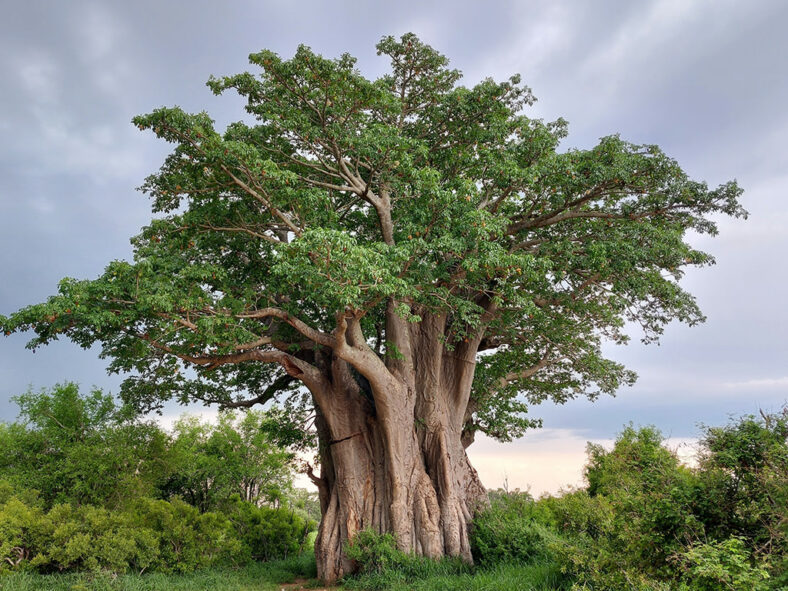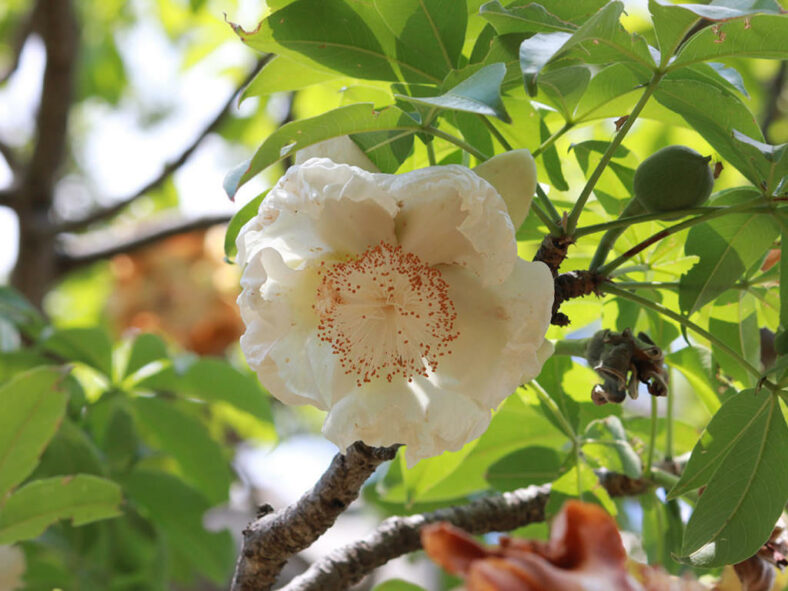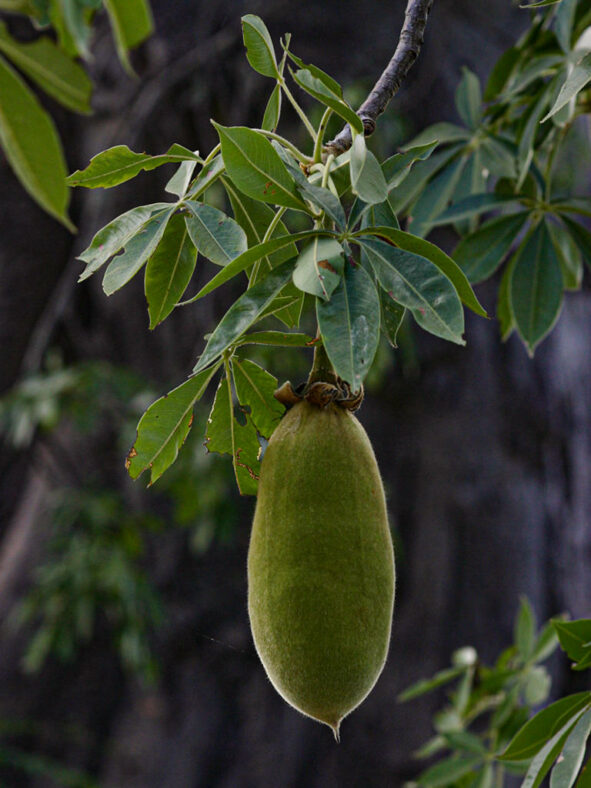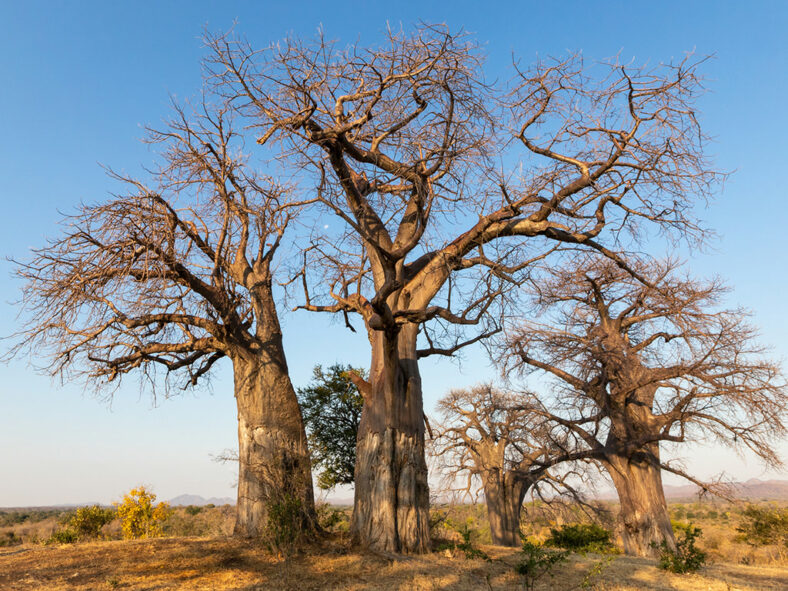Adansonia digitata, commonly known as African Baobab, is the largest succulent plant in the world. It has been traditionally valued as a source of food, water, health remedies, or places of shelter. The tree's massive trunk and thick tapering branches resemble a root system, which is why it is also known as the Upside-down Tree. According to a tale, God planted Adansonia digitata upside-down, and many traditional Africans believe that it grows upside-down.
Scientific Name
Adansonia digitata L.
Common Name(s)
African Baobab, Baobab, Cream of Tartar Tree, Dead-rat Tree, Lemonade Tree, Monkey-bread Tree, Upside-down Tree
Synonym(s)
Adansonia bahobab, Adansonia baobab, Baobabus digitata
Scientific Classification
Family: Malvaceae
Subfamily: Bombacoideae
Genus: Adansonia
Etymology
The specific epithet "digitata (dig-ee-TAH-tuh)" means "digitate; having fingers or toes" and refers to the digits of the hand, as the species has compound leaves with typically five (sometimes up to seven) leaflets, akin to a hand.
Origin
Adansonia digitata is native to semiarid sub-Saharan Africa. It grows in woodlands or thickets, mainly in drier lowland areas, from Angola through Southern Africa to East Africa as far north as southern Sudan and Ethiopia.
Description
Adansonia digitata is a massive deciduous tree with single or multiple cylindrical or fluted trunks that give rise to tapering, irregularly distributed branches. It can grow up to 82 feet (25 m) tall, and its trunks can reach up to 35 feet (10.7 m) in diameter. The trunks are covered with a grayish-brown bark layer up to 4 inches (10 cm) thick. The bark is usually smooth but can often be variously folded and seamed due to years of growth. The leaves are divided into usually 5 to 7 finger-like leaflets measuring up to 6 inches (15 cm) long and 2.8 inches (7 cm) broad. They drop during the winter and appear again from late spring to early summer, crowded at the ends of branches.
The flowering occurs in both the dry and the wet season. The solitary flowers have green, deeply 5-lobed calyx, white petals, and white androecium surmounted by 720 to 1,600 free filaments. They can measure up to 6 inches (15 cm) long and 5 inches (12.5 cm) in diameter and hang down on slender stalks that can reach up to 3 feet (90 cm) in length. The flowers appear in the late afternoon and fall within 24 hours, turning brown and smelling quite unpleasant. The fruits vary in shape from spherical to cylindrical and can measure up to 10 inches (25 cm) long and 4.8 inches (12 cm) in diameter. They have stiff, woody outer shells and contain floury acid pulp and black kidney-shaped seeds.

How to Grow and Care for Adansonia digitata
Adansonia digitata can be easily grown from seed. You can crack open the dry fruits to get the seeds. After that, wash away the powdery coating, soak the seeds in hot water, let them cool, and then soak them for another 24 hours before sowing. For best results, sow the seeds in spring or summer in a container with a well-draining seed-starting mix.
After that, cover the seed with sand, place the container in a warm, semi-shaded spot, and water regularly until germination. It may take 2 to 6 weeks for seeds to germinate. Once the seedlings are about 2 inches (5 cm) tall, transplant them into individual containers. Sandy soil with compost and bone meal is the best option for planting.
Adansonia digitata grows quickly when young and is suitable for large gardens, estates, or parkland as long as the soil is not waterlogged. When young, the plants do not look like their adult counterparts. They can be grown in containers for many years before planting. This way, you can move them to a warm position in a glasshouse or indoors behind a sunny window to protect them from frost damage.
Temperature: Adansonia digitata cannot tolerate frost. It grows best in USDA Plant Hardiness Zones 10b to 11b, with average minimum winter temperatures ranging from 35 to 50 °F (1.7 to 10 °C).
Toxicity of Adansonia digitata
Adansonia digitata is a traditional African food plant with various medicinal uses. The leaves, roots, flowers, fruit pulp, and seeds are all edible and non-toxic for people and pets.
Links
- Back to genus Adansonia
- Succupedia: Browse succulents by Scientific Name, Common Name, Genus, Family, USDA Hardiness Zone, Origin, or cacti by Genus
Photo Gallery
Click on a photo to see a larger version.



